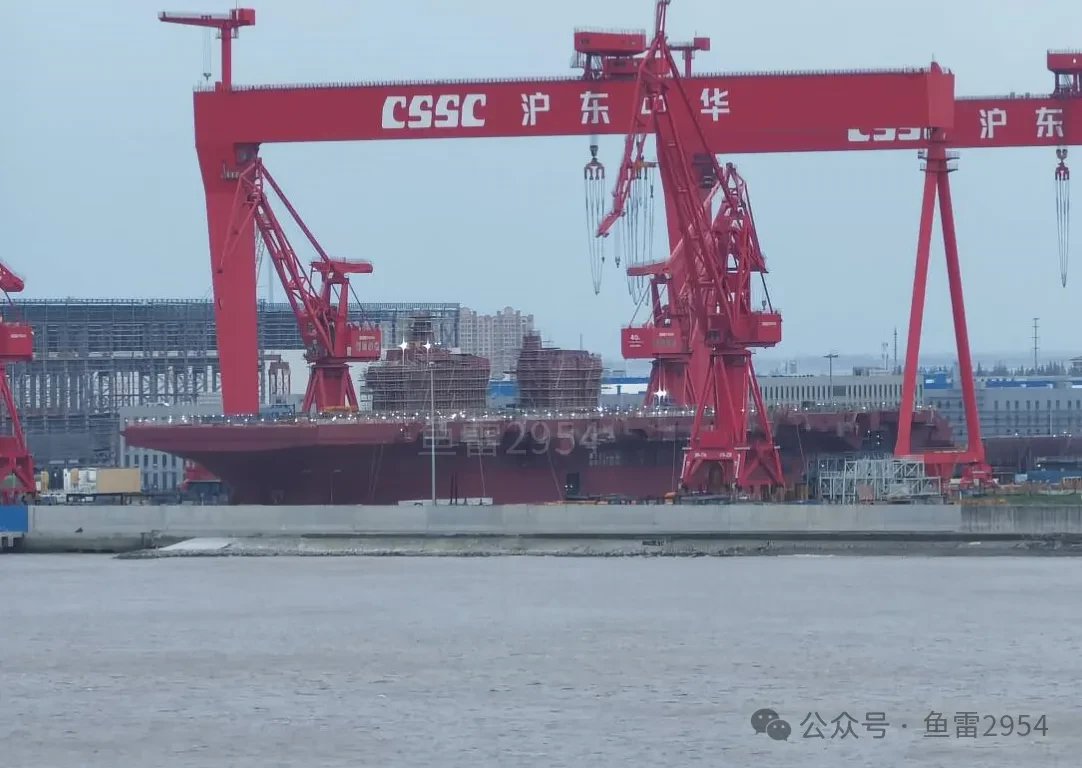The Chinese Navy’s amphibious assault ship, the Type-076, is rapidly taking shape, and new images reveal significant advancements in its construction.
Recent photos showcase the installation of two island superstructures, a distinctive feature that has set the defense community abuzz. With its massive size and unique design, the Type-076 promises to be a game-changer, enhancing China’s amphibious and air-operation capabilities.
Discussions about this vessel have been circulating in military circles for several years. This warship is currently being built at a shipyard on Changxing Island in Shanghai.
New images provide a clear view of the ship’s twin-island configuration. On September 26, photos surfaced showing the installation of one of its island superstructures. By the end of the month, the second island had been added, further solidifying the ship’s distinctive design.
By October 3, close-up shots of Type 076 showed that both island structures were still surrounded by scaffolding, but the vessel’s overall shape was now clear.

The ship is the successor to China’s Type-075 amphibious assault helicopter carrier, but it represents a significant leap in capability.
With a flight deck measuring approximately 260 meters by 52 meters—covering over 13,500 square meters, equivalent to three American football fields—the Type-076 is set to become the largest amphibious assault ship in the world.
The twin-island design is primarily used to enhance air operations, enabling efficient management of aircraft on the flight deck.
The design suggests that the ship will prioritize air power, with room to accommodate larger drones and fixed-wing aircraft. This focus on air capabilities is further reinforced by the expansive flight deck, which is wider than any seen on amphibious assault ships.
The ship is also expected to feature a catapult launch system, most likely an electromagnetic aircraft launch system (EMALS), which would be the first of its kind on an amphibious assault ship.
These systems, which are expected to be installed on the ship’s bow, will enable the launch of larger and heavier aircraft and stealthy, uncrewed combat air vehicles (UCAVs).
Unlike traditional steam-powered catapults, EMALS can launch smaller drones efficiently, offering increased operational flexibility. Additionally, the ship is likely to feature arresting gear, allowing for the recovery of fixed-wing aircraft, further underlining its air-focused mission.
The Type-076 is designed with multiple aircraft elevators: one at the stern and another on the port side.
These elevators will ensure the rapid movement of aircraft between the flight deck and hangar, enabling high-tempo air operations, a critical component of modern amphibious warfare.
While there is no indication that the ship will feature a ‘ski-jump’ ramp for aircraft takeoff, EMALS may render such a feature unnecessary.
Why Twin-Island Configuration?
China’s Type 076 amphibious assault ship is emerging as a hybrid vessel, combining elements of traditional amphibious ships and aircraft carriers. Its design hints at a dual role: transporting troops and vehicles for amphibious operations while providing substantial air support with drones and aircraft.
This makes the Type 076 a significant upgrade over the Type 075, placing it in a unique position between China’s current amphibious warship and its Fujian-class aircraft carrier.
However, the Type 076’s twin-island design is not entirely new. It mirrors the configuration of larger ships, such as the British Queen Elizabeth class aircraft carriers.
While this configuration is relatively rare in amphibious ships, it is found in Italy’s Trieste-class landing helicopter dock (LHD), which is closer in size to the Type 076.
This twin-island design is also being considered for India’s future aircraft carrier, Vishal. In 2019, BAE Systems proposed a Queen Elizabeth-class-inspired design to India to meet the requirements for their second domestically-built carrier.

The selection of two island superstructures on these vessels streamlines flight operations by distinguishing essential functions. While one island is responsible for ship navigation and overall vessel operations, the other exclusively manages flight control and aircraft operations.
This separation is especially relevant for Type 076, which is expected to handle a variety of air assets, including heavier fixed-wing drones. These unmanned aircraft require specific handling procedures, which may have influenced the decision to opt for two islands.
In addition to operational efficiency, the twin-island design offers aerodynamic benefits. Wind tunnel tests have shown that this configuration reduces air turbulence over the flight deck, which can otherwise complicate takeoffs and landings.
The twin-island setup improves the safety and efficiency of flight operations by minimizing turbulent air caused by the ship’s movement.
Additionally, it optimizes deck space because the two smaller islands occupy less area than one larger structure, allowing for greater flexibility in the supervision of aircraft and drones during missions.
- Contact the author at ashishmichel(at)gmail.com
- Follow EurAsian Times on Google News




